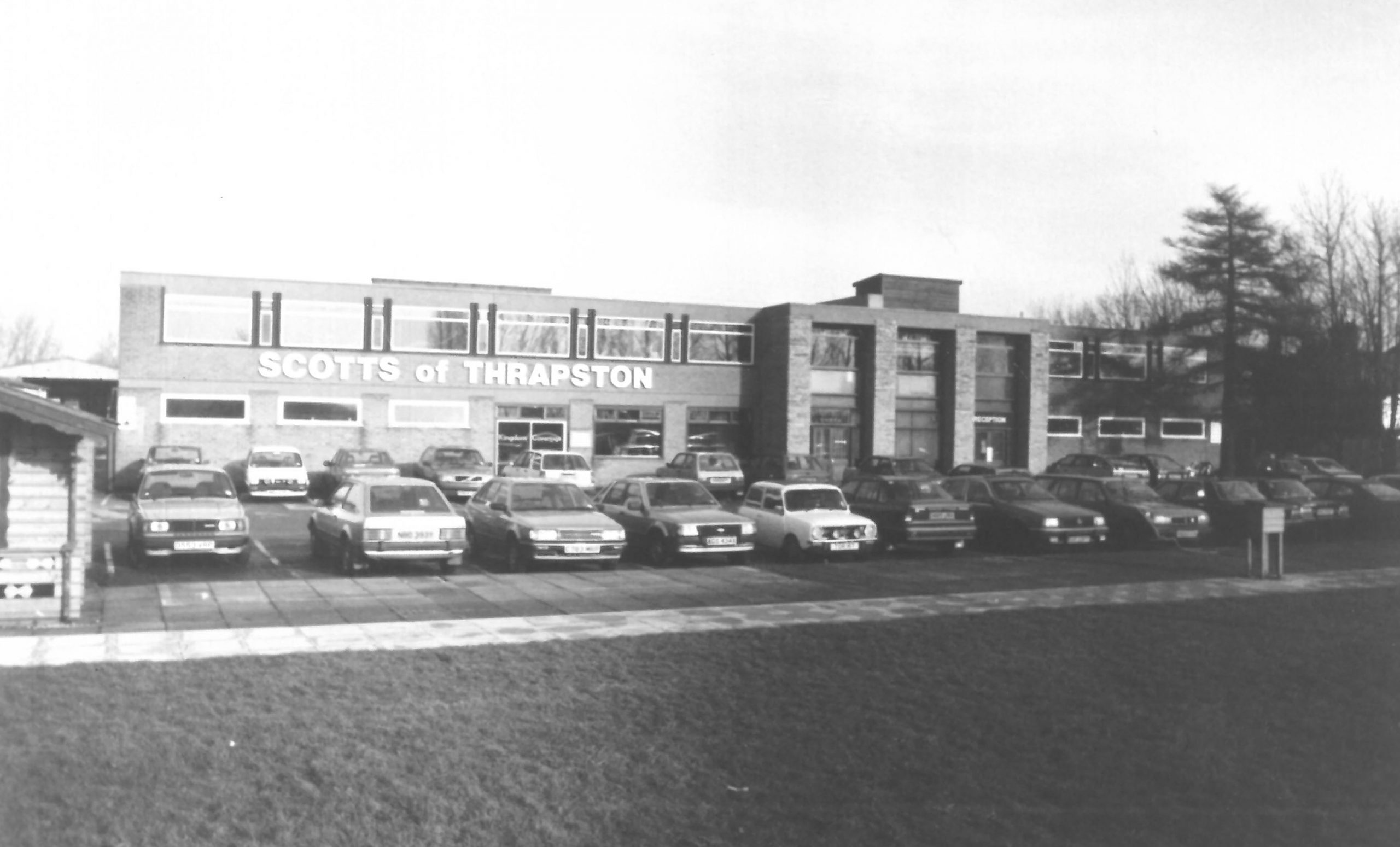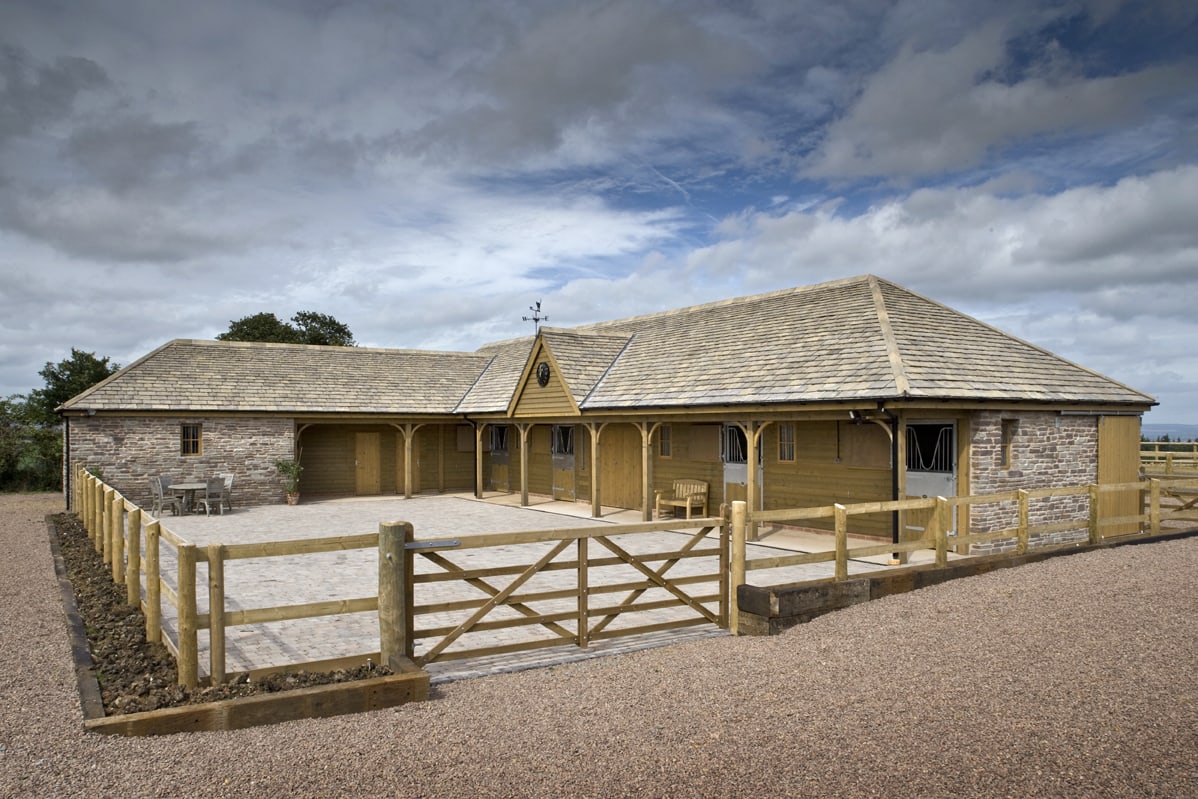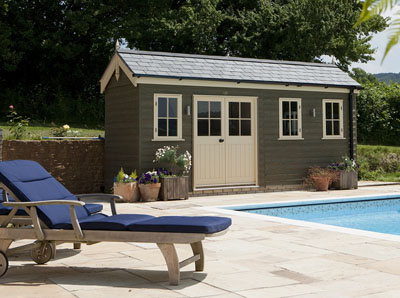Throughout the ages, we have always had a close relationship with timber. Its natural beauty, warmth, adaptability, and strength have long made wood a favourite construction material. As well as delivering tactile pleasure, wood helps us to reap the benefits of biophilic design where natural materials complement our everyday lives. Timber is a sustainable and renewable resource when sourced responsibly and promotes carbon sequestration helping to mitigate climate change.
Working with timber holds a cultural and historical significance because woodworking is an ancient craft with rich traditions. Scotts has been producing premium quality equestrian architecture for over half a century and our team is well placed to understand what makes the ideal equine environment for your horses’ health and wellbeing.
In our blog we look at how the properties of timber make it the best choice of construction material for your bespoke stable yard project.
Alternatives to Wooden Stables
Your choice of stable material
When you evaluate your preferences for a stable yard design, we recommend taking the following into account:
- Comfort: primarily, choose materials that will support your horses’ enjoyment of their environment and keep them safe.
- Air quality: select materials and construction methods that promote good air flow.
- Aesthetic appeal: choose materials that will complement your property and make a positive visual impact that you can enjoy for years ahead.
Some pros and cons of materials other than timber:
Metal stables
Although stables made from metal are highly durable and fire resistant, they have poor insulation qualities making the inside cold in winter and too hot in the summer. Rain and hail generate noise against metal surfaces that could be an annoyance for your horses.
Concrete stables
A strong and durable material, concrete offers a low maintenance option and is fireproof. It is an expensive material and can be hard on horses’ joints without the aid of rubber matting or thick bedding underfoot.
Brick or stone stables
During the Georgian era, often regarded as the Golden Age of stables, equestrian buildings were often constructed using brick or crafted from local stone. These classic materials undoubtedly deliver significant aesthetic appeal and a sturdy finish.
Stables made from brick are costly to build partly because the construction process is necessarily much longer and the don’t deliver the best insulating properties causing issues with temperature fluctuations throughout the seasons.
Synthetic materials
Stables made from rigid polyvinyl chloride (PVC) or thermoplastic polymers such as HDPE offer excellent durability and resistance to rot, insects, moisture, and decay. They are low maintenance and safe for horses. However, aesthetics are poor and plastics can have a negative impact on the environment.
Stables made from Wood
Timber is usually considered to the best material with which to construct equestrian stables for a number of reasons relating to equine wellbeing. These include:
- Safety: horses can injure themselves on sharp or uneven metal or concrete surfaces by kicking or rubbing. Constructing your stable using wood will reduce the risk of soft tissue injuries.
- Temperature control: timber helps to maintain humidity levels as it tends to absorb excess moisture and release it when the air is too dry. This helps to create balanced air quality.
- Insulation: a natural insulator, wood helps to maintain a steady temperature preventing extremes of heat and cold that could cause discomfort in your animals.
- Soundproofing: an environment crafted from timber is less stressful for horses because wood absorbs noise.
- Repair and maintenance: wooden structures tend to be easier and less expensive to maintain than concrete and metal buildings. Choosing Scotts’ premium hardwood stables which are made from pressure treated timber delivers a virtually maintenance free solution.
- Ventilation: wooden structures have better ventilation and breathe better than those made from metal, concrete, brick, or plastics. This reduces ammonia from urine and dust particles that can cause respiratory issues in horses.
- Environment and aesthetics: wooden stables blend better with natural surroundings and reduce stress for horses by creating a more pleasant and calming environment. They can also improve the perceived value of your property.
The natural beauty of wood contributes to a more horse-friendly home for your animals which is why we find that our clients prefer our timber stables.
Types of Timber
There are a variety of types of wood that can be used in the construction of equestrian stables.
- Oak: strong, durable, and highly resistant to wear and tear, oak is dense and heavy making it harder to work so it comes with a higher price tag.
- Pine: affordable and easy to handle, pine is widely available and easier to use in construction because of its lighter weight. It is softer and less durable than hardwoods which generates the need for more maintenance and repair.
- Spruce: light and easy to work with, spruce has a good weight-to-strength ratio and is relatively affordable. As a softwood, stables constructed using spruce will attract a higher maintenance burden.
- Douglas fir: this type of timber is strong and resists insects and decay well. It is relatively low cost and widely available. It can be more demanding to work with than fir and spruce.
- Cypress: the natural oils within this type of timber make it highly resistant to decay. It is less readily available than other timber types and can be expensive.
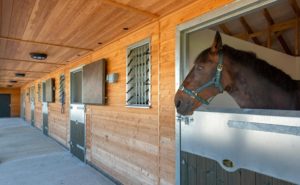
Choosing the right wood for your stable project
Talk to your supplier about options for wooden stables and they will help you to weigh up factors including:
Durability: stables are required to withstand heavy use and possible damage by horses. Hardwoods offer a better choice for areas of high wear and tear.
Cost: oak and cedar can be more costly but offer better longevity and require less maintenance than soft woods such as pine and spruce.
Safety: avoid timbers that split easily or have sharp edges that could cause injuries to your horses. All timber must be smoothly finished.
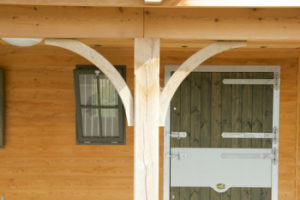
Which Elements of a Stable are made from Wood?
The key components of a timber stable include:
- Stable walls: interior and exterior walls made form wood offer great insulation properties and reduce noise creating a tranquil environment for your horses. Scotts use tongued and grooved shiplap boarding made from vacuum pressure impregnated European Redwood. Alternative timber choices from Scotts could include Western Red Cedar, Siberian Larch, or Oak.
- Loose box dividers: Scotts offer partitions and internal stable fronts manufactured using a combination of timber and hot-dipped galvanised steel, an exceptionally durable chip resistant powder coating, or stainless steel.
- Stable doors: Scotts’ loose boxes are fitted with a tongued and grooved pressure impregnated wooden stable door with a heavy-duty galvanised steel lining for extra protection.
- Roofs: the framework for your stable roof could include trussed rafters to hold tiles made from clay, cement or cedar shingles.
- Fencing: wooden fences around the outside of the stable yard or paddock are decorative and practical additions. These should be sturdy and high enough to prevent escapes.
- Feed and hay racks: wooden racks for holding feed and hay can be installed in each loose box and should be designed to provide easy access for your horse.
Your Bespoke Timber Stable Design
Whether your current equestrian buildings are made from a material other than timber, or your existing wooden stable yard is in need of an upgrade, Scotts is happy to discuss the relative properties of a range of construction materials and advise on the best option for your project. Talk to the experts first before making any firm decisions.
Contact us for a no-obligation conversation or site visit.

